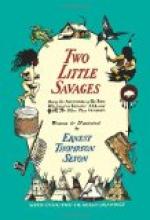Tracks
In the wet sand down by the edge of the brook he one day found some curious markings—evidently tracks. Yan pored over them, then made a life-size drawing of one. He shrewdly suspected it to be the track of a Coon—nothing was too good or wild or rare for his valley. As soon as he could, he showed the track to the stableman whose dog was said to have killed a Coon once, and hence the man must be an authority on the subject.
“Is that a Coon track?” asked Yan timidly.
“How do I know?” said the man roughly, and went on with his work. But a stranger standing near, a curious person with shabby clothes, and a new silk hat on the back of his head, said, “Let me see it.” Yan showed it.
“Is it natural size?”
“Yes, sir.”
“Yep, that’s a Coon track, all right. You look at all the big trees near about whar you saw that; then when you find one with a hole in it, you look on the bark and you will find some Coon hars. Then you will know you’ve got a Coon tree.”
[Illustration: The Coon track]
Yan took the earliest chance. He sought and found a great Basswood with some gray hairs caught in the bark. He took them home with him, not sure what kind they were. He sought the stranger, but he was gone, and no one knew him.
How to identify the hairs was a question; but he remembered a friend who had a Coon-skin carriage robe. A few hairs of these were compared with those from the tree and left no doubt that the climber was a Coon. Thus Yan got the beginning of the idea that the very hairs of each, as well as its tracks, are different. He learned, also, how wise it is to draw everything that he wished to observe or describe. It was accident, or instinct on his part, but he had fallen on a sound principle; there is nothing like a sketch to collect and convey accurate information of form—there is no better developer of true observation.
One day he noticed a common plant like an umbrella. He dug it up by the root, and at the lower end he found a long white bulb. He tasted this. It was much like a cucumber. He looked up “Gray’s School Botany,” and in the index saw the name, Indian Cucumber. The description seemed to tally, as far as he could follow its technical terms, though like all such, without a drawing it was far from satisfactory. So he added the Indian Cucumber to his woodlore.
On another occasion he chewed the leaves of a strange plant because he had heard that that was the first test applied by the Indians. He soon began to have awful pains in his stomach. He hurried home in agony. His mother gave him mustard and water till he vomited, then she boxed his ears. His father came in during the process and ably supplemented the punishment. He was then and there ordered to abstain forever from the woods. Of course, he did not. He merely became more cautious about it all, and enjoyed his shanty with the added zest of secret sin.




